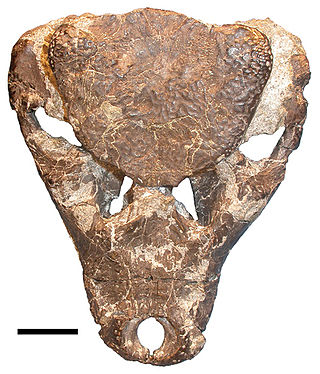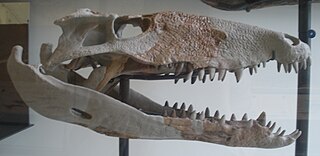
Simosuchus is an extinct genus of notosuchian crocodyliforms from the Late Cretaceous of Madagascar. It is named for its unusually short skull. Fully grown individuals were about 0.75 metres (2.5 ft) in length. The type species is Simosuchus clarki, found from the Maevarano Formation in Mahajanga Province, although one isolated multicuspid tooth of this genus was discovered in Kallamedu Formation of India.
Zaraasuchus was a gobiosuchid crocodyliform described in 2004 by Diego Pol and Mark Norell. It was found in the Red Beds of Zos Canyon, in the Gobi Desert of Mongolia, thus making it Late Cretaceous in age.

Gobiosuchus was a gobiosuchid crocodyliform described in 1972 by Polish palaeontologist Halszka Osmólska. It hails from the Late Cretaceous of Bayn Dzak, in the Gobi Desert of Mongolia.
Elosuchus is an extinct genus of neosuchian crocodyliform that lived during the Middle Cretaceous of what is now Africa.

Sichuanosuchus is an extinct genus of crocodyliform from the Late Jurassic and possibly Early Cretaceous of China.

Protosuchia is a group of extinct Mesozoic crocodyliforms. They were small in size and terrestrial. In phylogenetic terms, Protosuchia is considered an informal group because it is a grade of basal crocodyliforms, not a true clade.

Atoposauridae is a family of crocodile-line archosaurs belonging to Neosuchia. The majority of the family are known from Late Jurassic to Early Cretaceous marine deposits in France, Portugal, and Bavaria in southern Germany. The discovery of the genus Aprosuchus, however, extends the duration of the lineage to the end of the Cretaceous in Romania.

Pholidosauridae is an extinct family of aquatic neosuchian mesoeucrocodylian crocodylomorphs. Fossils have been found in Europe, Africa, North America and South America. The pholidosaurids first appeared in the fossil record during the Bathonian stage of the Middle Jurassic. Jouve & Jalil (2020) described postcranial material of a pholidosaurid from the Paleocene (Danian) of Ouled Abdoun Basin (Morocco), representing the most recent record of the family. The authors also reinterpreted putative Maastrichtian dyrosaurid Sabinosuchus as a pholidosaurid, and argued that at least two independent pholidosaurid lineages reached the Maastrichtian, among which one survived the Cretaceous–Paleogene extinction event. Before the publication of this study it was thought that the family became extinct during the Late Turonian stage of the Late Cretaceous.
Edentosuchus is a genus of protosuchian crocodyliform. It is known from fossils found in rocks of the Early Cretaceous-age Tugulu Group from the Junggar Basin, Xinjiang, China. Two partial skulls and several neck vertebrae are known to date. An articulated partial postcranial skeleton may also belong to this genus, but there is no overlapping material between it and known Edentosuchus specimens.

Iharkutosuchus is an extinct genus of basal eusuchian crocodyliform. Its fossils have been found in the Santonian-age Upper Cretaceous Csehbánya Formation in the Bakony Mountains of western Hungary.
Stolokrosuchus is an extinct genus of crocodyliforms that lived during the Early Cretaceous. Its fossils, including a skull with a long thin snout and bony knobs on the prefrontal, have been found in Niger. Stolokrosuchus was described in 2000 by Hans Larsson and Boubacar Gado. The type species is S. lapparenti. They initially described it as related to Peirosauridae, if not a member of that family. One study has shown it to be related to Elosuchus. However, more recent works usually find Stolokrosuchus to be one of the basalmost neosuchian, only distantly related to the elosuchid or pholidosaurid, Elosuchus. It was a semiaquatic crocodylomorph.
Kemkemia is a genus of probable crocodyliforms living in the Cretaceous, described from a single fossil that was recovered in 1999 from Morocco by an Italian team searching for fossil invertebrates. The fossil of Kemkemia dates from the Cenomanian age.
Mahajangasuchidae is an extinct family of notosuchian crocodyliforms. It currently contains two genera, Mahajangasuchus and Kaprosuchus, both of which lived during the Late Cretaceous in Gondwana. It is defined as the most inclusive clade containing Mahajangasuchus insignis but not Notosuchus terrestris, Simosuchus clarki, Araripesuchus gomesii, Baurusuchus pachecoi, Peirosaurus torminni, Goniopholis crassidens, Pholidosaurus schaumbergensis, or Crocodylus niloticus. Phylogenetically, Mahajangasuchidae is placed just outside pholidosaurids and more derived neosuchians.
Khoratosuchus is an extinct genus of neosuchian crocodylomorph which existed in northeast Thailand during the early Cretaceous period. Its type species is Khoratosuchus jintasakuli. Khoratosuchus is the youngest and most advanced Mesozoic crocodyliform yet known from Thailand. It possesses several distinctive features that help determine its phylogenetic position among crocodylomorphs, including secondary choanae relatively posterior and almost encircled by the pterygoid bones on the palate and a smooth dorsal surface of the skull.

Protosuchidae was a family of crocodyliform reptiles from the Late Triassic, Jurassic, and Cretaceous time periods. They were closely related to the Gobiosuchidae.

Sebecia is an extinct clade of mesoeucrocodylian crocodyliforms that includes peirosaurids and sebecids. It was first constructed in 2007 to include Hamadasuchus, Peirosauridae, and Sebecus. It was initially considered to be the sister taxon of the clade Neosuchia, which includes living crocodilians, although some later studies have placed it within Neosuchia as a basal clade. Sebecians were terrestrial crocodyliforms characterized by their deep snouts and ziphodont dentition. They first appeared in the Late Cretaceous, survived the Cretaceous–Paleogene extinction event, and became extinct in the Miocene epoch.

Ziphosuchia is a clade of mesoeucrocodylian crocodyliforms that includes notosuchians and sebecosuchians.
Tagarosuchus is an extinct genus of Early Cretaceous protosuchian-grade crocodyliform. Fossils of Tagarosuchus have been found from southern Siberia, including a nearly complete skull found near the village of Shestakovo in Kemerovo Oblast. Tagarosuchus was named in 1999, with the type species being T. kulemzini. Remains have been recovered from the Aptian-Albian Ilek Formation.

Uruguaysuchidae is a family of notosuchian crocodyliforms that lived in South America and Africa during the Cretaceous period. It includes the genera Araripesuchus and Uruguaysuchus. Below is a cladogram from Soto et al. (2011):
Paluxysuchus is an extinct genus of neosuchian crocodyliform known from the Early Cretaceous Twin Mountains Formation of north-central Texas. It contains a single species, Paluxysuchus newmani. Paluxysuchus is one of three crocodyliforms known from the Early Cretaceous of Texas, the others being Pachycheilosuchus and an unnamed species referred to as the "Glen Rose Form". Paluxysuchus has a long, flat skull that is probably transitional between the long and narrow skulls of many early neosuchians and the short and flat skulls of later neosuchians.












